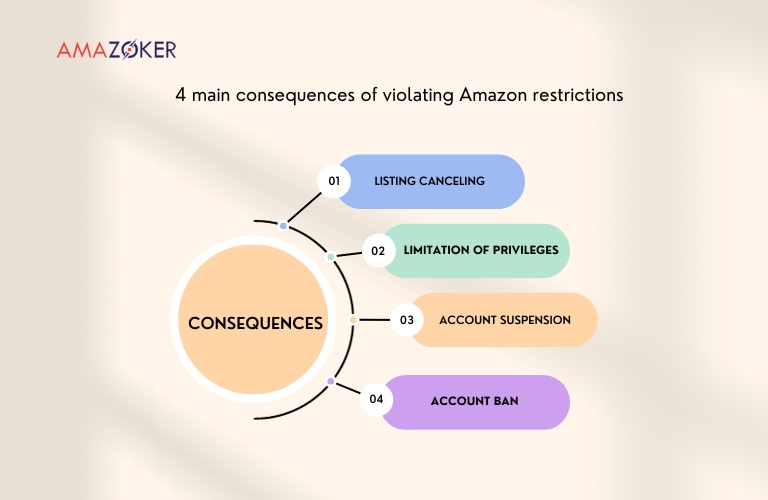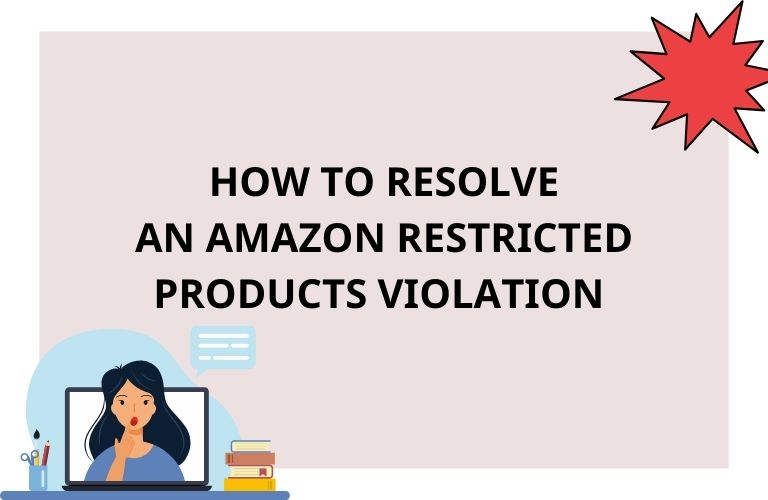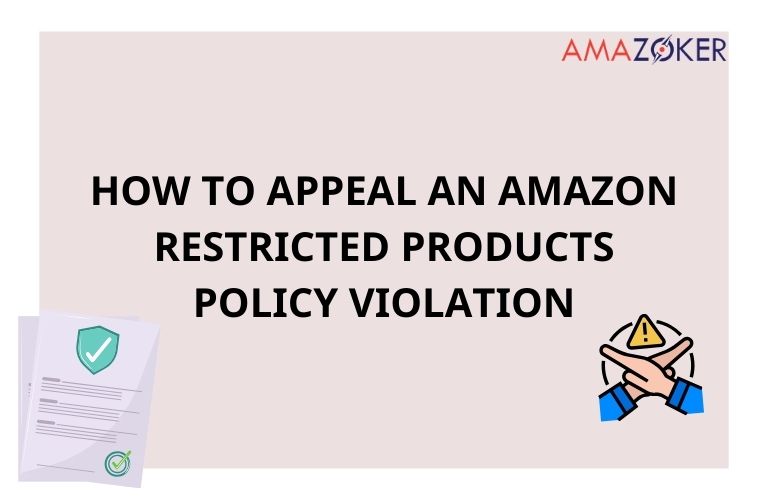Have you ever encountered Amazon Restricted Products Policy Violations? Do you know why this happens and how to address it? In fact, there are items that you’re not allowed to purchase or sell on Amazon. Some are strictly forbidden, while others are restricted from being sold. After reading this article, you will have sufficient knowledge about the policy, as well as know how to recognize and resolve the violation.
Table of Contents
- Amazon’s Restricted Product Policy
- Why does Amazon have product restrictions?
- Common reasons leading to Amazon’s Restricted Product Policy violations
- Other policy violations about listing
- What to do if you receive an Amazon’s Warning of Restricted Products
- Is It Worth Selling Restricted Categories on Amazon?
- Consequences of violating the restrictions
- How can you avoid such violations?
- How to resolve an Amazon Restricted Products Policy Violations
- Amazoker, which handles Restricted Products policy violations
- Frequently asked questions
Amazon’s Restricted Product Policy
Customers have confidence in the trustworthiness of their Amazon purchases. Products available for sale on Amazon must adhere to all legal requirements, regulations, and Amazon’s guidelines, particularly the Amazon restricted products policy. The sale of restricted products, including illegal, unsafe, or items that require prescriptions, is strictly forbidden.
Why does Amazon have product restrictions?
Foremost, Amazon prioritizes the safety, security, and quality of products purchased by its customers. Therefore, these products must adhere to industry standards, safety regulations, and possess required warranties. This requirement extends to various items, such as automotive parts, children’s clothing, and more.
Secondly, the marketplace aims to prevent any potential claims arising from the goods sold by sellers. This necessitates that listed items are legally permissible and comply with all market-specific regulations where they are being sold.
If you are a seller on Amazon, it’s essential to carefully review the following list of categories that contain one or more restricted products before listing any item:
- Alcohol
- Animals & Animal-Related Products
- Art – Fine Art
- Art – Home Decor
- Automotive and powersports
- Composite Wood Products
- Cosmetics and Skin and hair care
- CPAP Cleaning and Disinfecting Devices
- Currency, Coins, Cash Equivalents, and Gift Cards
- Dietary supplements
- Drugs and drug paraphernalia
- Electronics
- Explosives, weapons, and related items
- Export Controls
- Food & Beverage
- Gambling & Lottery
- Hazardous and prohibited items
- Human Parts & Burial Artifacts
- Jewelry & Precious Gems
- Laser products
- Lighting
- Lock Picking & Theft Devices
- Medical devices and accessories
- Offensive and Controversial Materials
- Pest control products and pesticides
- Plant and Seed Products
- Postage meters and stamps
- Recalled products.
- Recycling electronics
- Refrigerants: Ozone-Depleting Substances and Substitutes
- Strike anywhere matches.
- Subscriptions and Periodicals
- Surveillance Equipment
- Tobacco & Tobacco-Related Products
- Warranties, Service Plans, Contracts, and Guarantees
- Upholstered Furniture, Bedding, & Other Quilted Products
- Automotive tires, wheels, and rims

List of restricted categories on Amazon
If you provide a product that breaches Amazon restricted products policy, as outlined above, Amazon will implement appropriate remedial measures, including but not limited to the immediate suspension or termination of your selling privileges, disposal of inventory in our fulfillment centers without compensation, returning inventory, ending the business partnership, and permanent withholding of payments. A restricted products policy violation on Amazon can also lead to legal action, involving both civil and criminal penalties.
Common reasons leading to Amazon’s Restricted Product Policy violations
Of course, you want to ensure compliance with all regulations. However, the extensive list of categories containing restricted products can be quite lengthy, and the explanations for each can become quite intricate.
It’s your intention to steer clear of accidentally starting to sell products that might land you in trouble with Amazon (or the law). To prevent any inadvertent errors, it’s absolutely vital to comprehend the potential factors that could lead to a violation of Amazon’s Restricted Product Policy. Here are some examples:
- Listing prohibited items: Failure to review and comply with Amazon’s guidelines for restricted products can lead to the listing of items that are not allowed on the platform.
- Inaccurate product descriptions: Providing inaccurate or deceptive information about a product can lead to Amazon’s Restricted Product Policy violation, potentially resulting in punitive actions or penalties being imposed on the seller’s account.
- Failing to meet safety standards: Selling products that fail to meet the safety and quality standards specified by Amazon can result in Amazon policy violation about restricted products. These violations may even prompt Amazon to suspend your seller’s account.
- Restricted categories: Attempting to sell items in categories that require special approval without first obtaining the necessary permissions can lead to violations of Amazon’s policies.
- Insufficient documentation: Not providing requested documentation, such as certificates or licenses for specific products, can lead to the violation of Amazon restricted products policy.
- Ignoring region-specific rules: Selling products that are restricted in particular geographic areas can lead to policy violations if not handled appropriately.

Causes of Restricted Product policy violation
Other policy violations about listing
A listing policy violation on Amazon takes place when a seller does not adhere to Amazon’s regulations and guidelines for product listings. Such violations can lead to warnings, suspensions, or, in severe cases, account termination, which can significantly impact the seller’s ability to conduct business on the platform. In addition to Amazon’s Restricted Products Policy Violation, there are other Amazon policy violations, which include:
- Listing Policy Violation
- Product Safety Violation
- Authenticity Violation
- Used Sold as New Violation
- Customer Review Policies Violation
- Intellectual Property Violation
What to do if you receive an Amazon’s Warning of Restricted Products
If a seller receives a warning from Amazon regarding a restricted product violation, they should take the following steps:
- Review the Warning: Carefully read and understand the warning to identify the specific issue or policy violation that Amazon has pointed out.
- Close Listings: If Amazon has requested that you close listings of the restricted product, do so immediately to comply with their request.
- Investigate the Issue: Analyze your business operations and product listings to determine the root cause of the policy violation. It may involve issues such as selling prohibited items, inaccurate product listings, or other policy violations.
- Correct the Violation: Take steps to correct the violation. This could include removing or editing product listings, ensuring that your product details are accurate and compliant with Amazon’s policies.
- Contact Amazon Seller Support: If you believe the warning is in error or if you have made the necessary corrections, reach out to Amazon Seller Support. You can use the “Appeal” or “Contact Us” option within your seller account to explain your situation and seek clarification.
- Legal Consultation: In complex cases, consider consulting with an attorney who specializes in Amazon seller-related legal matters.
Is It Worth Selling Restricted Categories on Amazon?
Selling products within restricted categories on Amazon presents both opportunities and challenges. While these categories may offer unique chances and less market saturation, they also come with stringent guidelines and compliance obligations that sellers must meticulously adhere to. Here are some factors to consider before venturing into selling restricted products on Amazon:
Unique Market Opportunities
Restricted categories often feature specialized products in high demand but with limited competition. If you possess a distinct product falling within a restricted category and can meet all the required criteria, you might establish a profitable niche for your business.
Reduced Competition
Given that many sellers avoid restricted categories due to their complexities, entering these segments could mean encountering less competition. This reduced competition might result in greater visibility and improved sales for your listings.
Stringent Compliance Requirements
Selling in restricted categories entails strict adherence to Amazon’s guidelines, local regulations, and industry standards. Failing to meet these criteria could lead to account suspension or permanent closure. Sellers must be prepared to invest time, effort, and resources to comply with these rules.
Additional Expenses and Documentation
Certain restricted products might demand specific certifications, permits, or documentation before they can be listed on Amazon. Fulfilling these additional requirements may involve extra costs and time-consuming procedures.
Building Customer Trust
Successfully navigating restricted categories can bolster your brand’s reputation and establish your credibility as a seller committed to safety and compliance. This enhanced trust from customers may result in increased loyalty and recurring business opportunities.

Is It Worth Selling Restricted Categories on Amazon?
Consequences of violating the restrictions
Violating restrictions on Amazon can result in various consequences, ranging from mild to severe. These consequences may include:
Cancellation of Your Listing:
If Amazon detects a violation, it may promptly remove the listing associated with the restricted product. This action aims to prevent further sales of the item in question.
Limitation of Your Listing Privileges:
Amazon might impose restrictions on your account, limiting your ability to list certain types of products or use specific features. This limitation serves as a measure to ensure future compliance.
Suspension of Your Account:
For more serious or repeated violations, Amazon may take the step of suspending your seller account temporarily. During the suspension period, you lose the ability to conduct any selling activities on the platform. This is a significant disruption to your business operations.
Ban of Your Account:
In cases of severe or repeated policy violations, Amazon may decide to permanently ban your seller account. This is the most severe consequence, resulting in a permanent loss of selling privileges on the platform. It is a critical measure to protect the integrity of the marketplace.
It’s crucial for sellers to adhere to Amazon’s policies and guidelines to avoid these consequences. Regularly reviewing and understanding Amazon’s rules, keeping products in compliance, and promptly addressing any violations are essential steps to maintain a healthy and sustainable selling business on the platform.

Amazon seller can get many consequences if violating Amazon restrictions.
How can you avoid such violations?
Newcomers often encounter restricted product violations due to oversight in reading guidelines. However, there are strategies to prevent such violations:
Adhere to guidelines:
Just like any platform, understanding Amazon’s instructions is crucial. Product regulations vary by country, and what’s prohibited in one location may be permissible elsewhere. Amazon delineates these rules accordingly. It’s vital to identify your region and thoroughly review the guidelines. Additionally, some products are universally prohibited across Amazon marketplaces, and it’s essential to review these as well.
Disclose product ingredients:
Each product comprises specific manufacturing elements, some of which might be prohibited. Transparently presenting these ingredients is critical. Amazon might perceive illegal components in your product if these are unclear. Clearly displaying your inventory elements can prevent suspension. Violations may lead to Amazon terminating your registration.
Report system glitches:
At times, ineffective email systems or internal errors trigger issues. You might receive automated emails from Amazon regarding restricted product violations, even without corresponding notifications on the dashboard. Such internal system errors can be frustrating. Contact Amazon support directly, detailing the problem and requesting a swift resolution. In certain instances, these notifications can be disregarded after verification.
How to resolve an Amazon Restricted Products Policy Violations
If you’ve received a notification of Amazon restricted product policy violations, there are several steps you can follow to resolve the issue. Here are some general guidelines:
- Identify the underlying issue: Carefully review the notification from Amazon to understand the specific product policy violation, then determine the cause of the violation and take appropriate steps to rectify it. For instance, if the product is not suitable for a certain age group, remove it from your catalog.
- Submit an Amazon appeal letters: Draft an appeal letter that outlines the actions you’ve taken to address the Amazon policy violation warnings and prevent their recurrence. Clearly acknowledge the violation, provide a detailed explanation of the corrective actions taken, and demonstrate your commitment to compliance. Ensure you include any relevant documentation or evidence that supports your case.
- Await Amazon’s response: After submitting your appeal, patiently wait for Amazon’s response. The response time can vary, ranging from a few days to several weeks.
- Take corrective measures: If Amazon approves your appeal, make the necessary changes to ensure that the restricted products policy violations don’t happen again in the future. This may involve updating product listings, improving your quality control processes, or enhancing your inventory management practices.
- Monitor your account’s health: Keep a close watch on your account health metrics to ensure that you remain in compliance with Amazon restricted products policy. Regularly check your account’s health dashboard on Seller Central to monitor any performance notifications or warnings. Address any new issues immediately by taking corrective actions and submitting appeals if necessary.

Steps to resolve an Amazon restricted products violation
Amazoker, which handles Restricted Products policy violations
The above is the complete set of detailed steps to support you in the process of appealing to reinstate your product listings and your account. If you still have any questions or encounter any difficulties during this journey, please reach out to Amazoker for the fastest and most effective assistance.
Amazoker provides specialized services in the realm of Amazon account appeals and Ungate service. Their offerings encompass complimentary consultations, examination of appeal profiles, composing and presenting appeals to Amazon, support with communication and negotiations, guidance for establishing and overseeing new accounts, and keeping you informed about Amazon’s policies.
For additional details, sellers have the option to visit Amazoker at amazoker.com or get in touch via contact@amazoker.com or by calling +1 580 262 6126.
Frequently asked questions
Let’s discover the commonly asked questions about Restricted product:
Q: What is restricted product policy?
The restricted product policy on Amazon refers to guidelines and regulations that restrict the sale of certain products on the platform. These restrictions are in place to ensure compliance with safety standards, legal requirements, and to maintain the overall integrity of the marketplace. Sellers must adhere to these policies, and failure to do so may result in account suspension or other penalties.
Q: How long do product policy violations stay on Amazon account?
The duration for which product policy violations stay on an Amazon account can vary. In general, Amazon retains a record of past violations, and they may influence account health for an indefinite period. However, the specific impact and duration can depend on the severity of the violation and the seller’s overall performance. The violation may be removed from account health after 180 days if the seller doesn’t make any appeal.
Q: How do I remove a violation from my Amazon seller account?
To remove a violation from your Amazon seller account, address the root cause of the violation by correcting the issue. Submit a well-crafted Plan of Action (POA) to Amazon, outlining the steps taken to rectify the problem and prevent future violations. If Amazon accepts your POA, the violation may be removed from your account.
Amazon Restricted Products Policy Violations may result in a listing removal or account deactivation, but you can prevent these issues by avoiding listing the restricted products highlighted in the Amazon policy. If your listing still gets hit by a notification of a restricted product, an appeal is still possible, or you can reach out to the experts at Amazoker for generous support.











